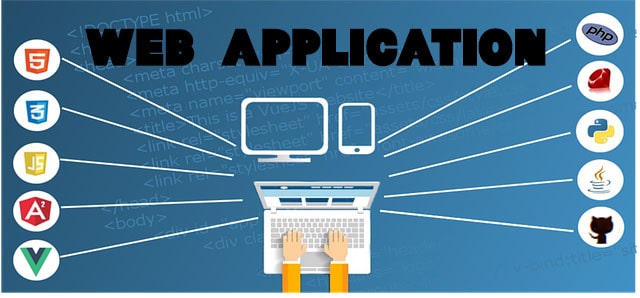The number of people accessing content remotely over their handheld devices has been increasing rapidly. This has made web application development an inevitable trend to be followed by developers. Whether it be e-commerce or entertainment companies or banking and education firms, every sector includes web application development to create an enhanced customer experience.
From static web pages to effective, secure, faster, and highly interactive, web applications have come a long way with the unfolding of Ajax. The lets users have easy accessibility and an improved, personalized experience right from the browser they surf through.
Putting Web App in simple terms – ‘A web app is an interactive computer program, designed with web technologies (CSS, HTML, more), which stores an enormous database that is further used by a user or team to conduct tasks on the internet.’
Now, as you’ve learned the meaning and functional role played by web applications as a key solution to digital issues, you could be wondering, ‘how to create an app from scratch’ and what elements do you need to develop a functional app.
With the advanced tools and software available, creating a web application has become quite simpler and easier. Prior to knowing the web application development process, let’s first shed details on vital aspects needed.
Requirements For Web App Development
To make a web application, there are certain prerequisites including technical as well as non-technical functions. Here’s a list of elements that need to be considered while developing a web application.
Backend languages such as Python, PHP, Java, and more. It is the server-side development meant to create the core functionalities of the application.
Frontend development, also known as client-side development that includes languages such as CSS, Javascript, HTML, and more. It decides over the structure, design, behavior, and content of a web app – improving the sight of the app.
DevOps Programming combines tools and practices to deliver a fast, frictionless web experience. In other words, it is virtually hosting a web app effectively.
Apart from these technical bits, you need to plan on content to be included, operations to be developed, scalability, encryption system, and more.
Now, as you’ve decoded the requisites, let’s sail the wind across the process of creating an app.
How To Create An App From Scratch?
Toss around this easy-to-follow app development guide and build a potent app.
Step 1: Form an Idea
As similar to other processes, the first step you need to take is finding an idea for building your app. Your idea should address what exactly people look for. Your idea should interest people, engage them in your app and make them interact for a longer period. Once you’ve generated an idea, go through these points and check whether your plan focuses on this or not.
- Your target audience, their needs, and problems
- A solution to a problem faced by the target audience
- Time required to build the application
- Key features of your application
- App design cost
Step 2: Industry Research
Once you’ve hand-picked an idea, it’s necessary to do the market research accurately. Identify if your app achieves product-market fit. Analyze the market accurately, examine the potential for your idea, look at your competitors and seek their direction.
- Whether the same app exists or not
- If there’s a demand for your app
- Scope of your idea
Step 3: Determine Functionality
Know what your app will do. You need to identify the USP or the prime functionality of your app that will differentiate it from competitors. You should enlist several features of your app and decide on one core feature that makes your app interesting. Your functions also answer all problems faced by your target market.
The basic functions you will need during the web development process are account creation, passwords, contact details, further leads, and more.
Step 4: Outline of your Web App
From navigation buttons, contact forms, advertisement banners, buttons, and other elements – Sketch what your web app will look like and what are the functions it will include. The best way to ignore failure is having two or three alternatives, that you could implement anytime in between if a sketch doesn’t work anymore.
Sketch everything –
- Design of your sign up screen
- Landing page
- Product/Services page
- Contact page
Step 5: Workflow Process Planning
Establish a systemic workflow that consists of all aspects of your web app. This stage of your web app development will include the resources you need, app design cost, technology requirements, the time frame needed, algorithms you’ll need to design the app, and more.
Step 6: Wireframes and Prototypes
As you’ve planned on your workflow process, now it’s time to put your working model into action. A wireframe is a well-structured sketch on a computer that shows how your app pages will be designed like.
Once you’ve designed the wireframe, the next step is to add interactive elements to the wireframes, known as prototypes. Adding prototypes help you get an exact visual appeal of your web app.
Step 7: Evaluate your Idea
The next step is to check how well your idea will work amid the competitive market scenario. You should validate the potential of your idea by testing it thoroughly. Think of how your end-users interact with your app. You can share your web app prototype with your colleagues, or friends and gather feedback.
Taking a note of feedback, you can identify the areas you’re falling behind and address them effectively.
Step 8: Integrate Advanced Technology
As you’ve entered the development phase with prototypes and wireframes, you need to select the most productive technology for your web app. The better technology you use, the less will be the operational cost, effort, resource wastage, and more.
Choose the high-yielding framework, libraries, platforms, languages, and more.
Step 9: Build Database & Well-performing App
At this stage, it’s time to get settled on a plan of action. Look up what data you’ve to store, how to arrange the structured data, and ways to segregate data. As you’ve determined the right data storage needs and requirements, you should also ensure your database is secured.
Idea, sketch, wireframe, validation, database – all sorted! What’s next? The consequent step is to build a high-performing backend, an interactive front end, and everything in between. App frontend development begins with a code editor, compilation framework using Webpack/Grunt, frontend framework, and configuration. Whereas, backend includes building server pages, adding sign up details like username, password, and more.
Step 10: Testing and Hosting
Testing is a crucial stage in every process. You’ll detect bugs only if you administer tests at the right time. Perform software quality assurance while building a web app and correct each of your iterations succeedingly.
As you’ve tested and verified its reliability, the next step you need to do is choose an appropriate server to host your web app. Purchase a domain, establish an SSL certificate, and select a cloud services provider.
Step 11: Final Deployment
As you’ve performed all the above 10 stages, the next step you’ve to hook into is making the web app live. Give the web app controls, codes, source tools, and everything in between to your end-user. Deploy your app onto the hosting server and let users have the benefits of your user-friendly interface.
Final Thoughts
With the industry revolving around the internet, the web application isn’t a need for modern-day businesses. It has now become a crucial part of every company to survive in the market and thrive amid tough competition.
To drive digital change smoothly, the web app is the digital image every company needs to create. If creating a web app is the need of the hour for your business too, follow this in-detailed guide to ‘how to create an app from scratch‘ and mark your costing accordingly.
Also Read: Can Social Media Marketing Increase Brand Awareness? Must Read








